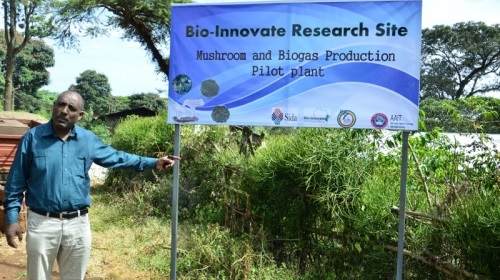
The mushroom production and demand by customers in Ethiopia is growing from time to time; as this indicates that the habit of consuming mushroom is growing.
By Abebe Wolde Giorgis (The Ethiopian Herald) |
In Ethiopia, cultivating food plants and breeding animals for milk and meet is a century-old practice; but due to various reasons, the types and variety of foods derived from plant and animals are very few as compared to the other countries.
According to the recent local nutritionists report, in Ethiopia there are only 50 kinds of plant and animal products to be consumed while more than three thousand kinds of plant and animal products are going to be consumed in Asia.
In Ethiopia, the types of food consumption is highly governed by religious and cultural values. As the result, only few types of foods are consumed by the society.
In this regard, Plant Scientists confirmed that there are numerous edible wild plants but due to the none domestication of the plants, the society is inhibited from consuming those edible plants and failed to get the nutrition content from those plants.
Currently, the government widens options for providing food varieties to its society. For instance, people cultivates Moringa or ‘Shiferaw’ and Cactus plants, which have high nutritive value. In a similar way, the cultivation of mushroom is getting ground in many parts of the country.
The Addis Ababa City Administration Agriculture Office with the collaboration of the China Aid Technical Cooperation Program of Senior Agricultural Group, expanded the cultivation of mushroom in Addis Ababa and in the outskirt of the city, that is, in Holeta town. There is one mushroom farm in the town owned by the City Administration Agriculture Office, which employed seven workers who receive sufficient training on cultivation.
READ: Ethiopian Honey Farmers Struggle with Sticky Traditions
Begashaw Taffesse is a worker at the farm and serves for three years. From time to time, he enhanced his skill of producing mushroom. According to him, there are various places which the mushroom production is processed. As working at the laboratory requires sanitation, workers always clean their shoes and clothes from the outdoor to prevent contaminant elements.
When they prepare for cultivation of mushroom at the laboratory, there are various elements combined together. 25 kilos of cotton seeds, 2 kilos of straw which has carbohydrate elements and 400 gram gyp-son which has calcium carbonate which has catalyst elements, mixed with water and then packed with plastic bags and boiled in to the electrically powered boiler. After that, it is preserved in dark room and a week later, it is again put in the green house. In this place, the mixed elements color will be changed in to white.
Next to this, it will be preserved in green house for 21 days and watered twice a day and to protect the place from hit the ground also watered daily. With in seven days, the mushroom seedling will be appeared after that with in a week, it will be harvested and supplied to the market. One mushroom seedling can planted four times after the first cut took place.
Kumeshi Waki is a graduate with B.A. degree from Ambo University in Plant Science and worked in the center for two years. As to her, the mushroom production and demand by customers is growing from time to time; and this indicates that the habit of consuming mushroom is growing.
Customers often take trainings how to cook mushroom food. It can be eaten with bread and Injera. In addition, it can be prepared with meet, egg and tomato. Asked weather the price of the mushroom at the market is fair or not, Kumeshi said that, previously one kilo of mushroom was sold by 60 Birr, but now, the price is sore and rose to 80 birr per kilo. With regard to the challenge, she said that the major challenges in the production of mushroom is power interruption.
When the electric went off the laboratory work and the boiling activity will be disrupted. The interruption of electric city also causes for the interruption of water. When such adverse situation occurs, they resort to utilize the stored water from the tanker.
Chinese Mushroom Production Adviser Zheng Aibao on his part said that, he came across to the center three years ago after he was invited by the city administration agriculture office officials since then, he worked together with the office in different places.
Mushroom cultivation can be easily done by taking the seedling from the center, every body can cultivate mushroom inside his residential compound at the household level in a simple way. As it has high protein content, it will play crucial role in achieving the national agenda of ensuring food and nutrition security.
As to him, Ethiopia has high potential of cultivating mushroom in quality and number. It can enhance nation’s foreign currency earning capacity from mushroom exports.
Regarding the challenges facing the production of mushroom, Zheng said that the non-availability of low cost technology impede the progress of the production. In order to address the problems observed in the expansion of mushroom cultivation, Zheng and his colleagues are trying their level best to innovate the required technology, cooperating with Addis Ababa University’s Faculty of Technology.
Source: The Ethiopian Herald
——
Other stories:
- Ethiopian Honey Farmers Struggle with Sticky Traditions
- Ethiopian Farmers to Benefit from 20 US-Funded Service Centers
- Improved Malt Barley: New Income Potential for Ethiopian Farmers
- Investing in Resilience Helps Families Find Hope in the Face of Drought in East Africa
- USAID-DuPont Partnership Helps Hundreds of Thousands of Ethiopian Farmers Transform Production and Livelihoods
